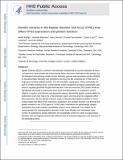| dc.contributor.author | Rathje, Mette | |
| dc.contributor.author | Waxman, Hannah Katherine | |
| dc.contributor.author | Benoit, Marc | |
| dc.contributor.author | Tammineni, Prasad | |
| dc.contributor.author | Leu, Costin | |
| dc.contributor.author | Loebrich, Sven | |
| dc.contributor.author | Nedivi, Elly | |
| dc.date.accessioned | 2020-11-05T20:30:36Z | |
| dc.date.available | 2020-11-05T20:30:36Z | |
| dc.date.issued | 2019-01 | |
| dc.date.submitted | 2018-11 | |
| dc.identifier.issn | 1359-4184 | |
| dc.identifier.issn | 1476-5578 | |
| dc.identifier.uri | https://hdl.handle.net/1721.1/128368 | |
| dc.description.abstract | Bipolar disorder (BD) is a common mood disorder characterized by recurrent episodes of mania and depression. Both genetic and environmental factors have been implicated in BD etiology, but the biological underpinnings remain elusive. Recently, genome-wide association studies (GWAS) of neuropsychiatric disorders have identified a risk locus for BD containing the SYNE1 gene, a large gene encoding multiple proteins. The BD association signal spans, almost exclusively, the part of SYNE1 encoding CPG2, a brain-specific protein localized to excitatory postsynaptic sites, where it regulates glutamate receptor internalization. Here we show that CPG2 protein levels are significantly decreased in postmortem brain tissue from BD patients, as compared to control subjects, as well as schizophrenia and depression patients. We identify genetic variants within the postmortem brains that map to the CPG2 promoter region, and show that they negatively affect gene expression. We also identify missense single nucleotide polymorphisms (SNPs) in CPG2 coding regions that affect CPG2 expression, localization, and synaptic function. Our findings link genetic variation in the CPG2 region of SYNE1 with a mechanism for glutamatergic synapse dysfunction that could underlie susceptibility to BD in some individuals. Few GWAS hits in human genetics for neuropsychiatric disorders to date have afforded such mechanistic clues. Further, the potential for genetic distinction of susceptibility to BD from other neuropsychiatric disorders with overlapping clinical traits holds promise for improved diagnostics and treatment of this devastating illness. | en_US |
| dc.language.iso | en | |
| dc.publisher | Springer Science and Business Media LLC | en_US |
| dc.relation.isversionof | http://dx.doi.org/10.1038/s41380-018-0314-z | en_US |
| dc.rights | Creative Commons Attribution-Noncommercial-Share Alike | en_US |
| dc.rights.uri | http://creativecommons.org/licenses/by-nc-sa/4.0/ | en_US |
| dc.source | PMC | en_US |
| dc.title | Genetic variants in the bipolar disorder risk locus SYNE1 that affect CPG2 expression and protein function | en_US |
| dc.type | Article | en_US |
| dc.identifier.citation | Rathje, Mette et al. "Genetic variants in the bipolar disorder risk locus SYNE1 that affect CPG2 expression and protein function." Molecular Psychiatry (January 2019): doi.org/10.1038/s41380-018-0314-z © 2019 Springer Nature Limited. | en_US |
| dc.contributor.department | Massachusetts Institute of Technology. Department of Brain and Cognitive Sciences | en_US |
| dc.contributor.department | Picower Institute for Learning and Memory | en_US |
| dc.contributor.department | Massachusetts Institute of Technology. Department of Biology | en_US |
| dc.relation.journal | Molecular Psychiatry | en_US |
| dc.eprint.version | Author's final manuscript | en_US |
| dc.type.uri | http://purl.org/eprint/type/JournalArticle | en_US |
| eprint.status | http://purl.org/eprint/status/PeerReviewed | en_US |
| dc.date.updated | 2019-10-03T15:52:09Z | |
| dspace.date.submission | 2019-10-03T15:52:11Z | |
| mit.metadata.status | Complete | |
